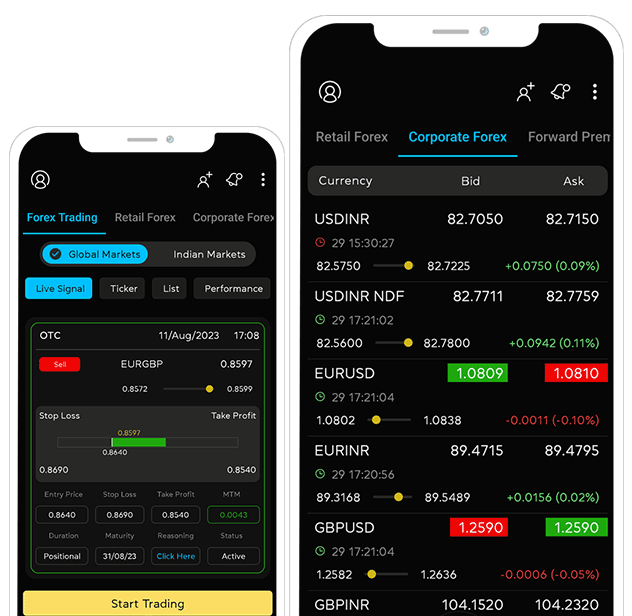Adapting Coporate Forex Strategies Amid Central Bank Policy Shifts in 2024

2024 stands out as a pivotal year for businesses managing foreign exchange (forex) exposure. Central banks across major economies are recalibrating their monetary policies, and these shifts have profound implications for corporations reliant on cross-border trade. To navigate these waters, companies must refine their forex strategies to align with the evolving landscape of live forex rates, real-time exchange rate tracking, and other critical currency management tools.
Understanding the Current Policy Landscape
Central banks worldwide are adopting diverse strategies to tackle challenges like inflation, economic recovery, and geopolitical instability. The U.S. Federal Reserve, for instance, is carefully balancing interest rate hikes to curb inflation without stifling growth. Meanwhile, the European Central Bank (ECB) is navigating the complexities of energy price shocks and supply chain disruptions.
For businesses, these policy shifts directly influence currency volatility. A corporation importing goods from Europe must closely monitor the live exchange rate between the euro and its base currency. Similarly, exporters face risks when central bank policies cause rapid fluctuations in real time exchange rate.
The Role of Technology in Managing Forex Risks
One of the most significant advancements in corporate forex management is the integration of technology to track live forex rates. Real-time exchange rate platforms empower businesses to make informed decisions quickly. For instance, a company hedging its exposure to the Japanese yen can use live forex prices to lock in favorable rates before market conditions change.
Additionally, automation and artificial intelligence (AI) have enhanced the accuracy of forecasting. Predictive analytics tools leverage historical data and current trends to predict potential movements in live exchange rates. By integrating these tools, companies can mitigate risks associated with sudden market fluctuations.
Strategies for Adapting to Policy Shifts
- Diversified Hedging: A robust hedging strategy remains the cornerstone of effective forex management. In 2024, businesses should consider diversifying their hedging instruments—ranging from forward contracts to options—to address specific risks tied to live forex rates.
- Dynamic Risk Assessment: Central bank policies can lead to rapid changes in currency markets. A proactive approach to risk assessment, incorporating real time exchange rate and real-time exchange rate updates, is essential for staying ahead of the curve.
- Collaborative Decision-Making: Aligning treasury teams with other business units ensures cohesive responses to currency risks. Collaboration enhances the ability to act on live exchange rate data, optimizing financial outcomes.
- Scenario Planning: Businesses should prepare for multiple policy scenarios. For instance, if a central bank unexpectedly shifts its policy stance, having pre-planned responses based on live forex rates minimizes the impact on profit margins.
Central Bank Policies and Sector-Specific Impacts
Different industries experience varying levels of exposure to forex risks based on central bank actions.
- Manufacturing: Manufacturers reliant on imported raw materials are particularly sensitive to changes in live forex prices. A sudden appreciation of the base currency can make imports cheaper, but volatility can disrupt supply chain budgets.
- Technology: The tech sector, which often operates globally, relies heavily on real-time exchange rate insights. Startups and multinational corporations alike need to manage currency exposure when paying overseas suppliers or repatriating profits.
- Travel and Tourism: Fluctuations in live exchange rates directly impact pricing strategies for international travel operators. Favorable rates can boost demand, while unfavorable movements can deter travelers.
The Importance of Monitoring Live Forex Rates
The value of staying updated on live forex rates cannot be overstated. For example, companies engaging in spot transactions need to act swiftly when favorable rates appear. Missing out on advantageous real time exchange rate could result in higher costs or reduced profit margins.
Businesses should integrate platforms that provide real-time exchange rate updates to streamline decision-making. These tools not only enhance accuracy but also enable companies to respond promptly to market movements, a crucial factor in today’s volatile environment.
Preparing for Long-Term Trends
While short-term fluctuations in live forex prices dominate headlines, businesses must also prepare for long-term trends. In 2024, major factors affecting exchange rates are:
- Geopolitical Developments: Trade negotiations, sanctions, and conflicts play a significant role in shaping currency markets. Companies should monitor geopolitical risks and their impact on live exchange rates.
- Economic Divergence: Differences in economic recovery rates across regions influence forex markets. For instance, faster recovery in emerging markets could lead to stronger currencies, affecting live forex rates for multinational businesses.
- Technological Adoption: The rise of digital currencies and blockchain technology introduces new dimensions to forex trading. While not yet mainstream, these innovations could eventually reshape how businesses approach live forex prices.
Leveraging Data for Strategic Advantage
Data-driven decision-making is a game-changer in corporate forex strategies. By analyzing trends in live forex rates and historical data, companies can identify patterns that inform better strategies. Predictive models, combined with real-time exchange rate tracking, offer a competitive edge in mitigating risks.
Moreover, businesses should invest in training their teams to interpret live forex prices effectively. A well-informed team can capitalize on opportunities while minimizing exposure to adverse movements.
Conclusion
As central bank policies continue to evolve in 2024, the need for agile and informed forex strategies has never been greater. Businesses must leverage technology, diversify their hedging instruments, and maintain vigilance over live forex rates to navigate the complexities of currency markets.
By staying attuned to real-time exchange rate updates and integrating predictive tools, companies can safeguard their financial health amid volatility. Ultimately, adapting to these shifts not only mitigates risks but also positions businesses to thrive in a rapidly changing global economy.
Recent Blog
Want to manage Forex?
Newsletter signup
Receive forex updates right in your mail box or Whatsapp













